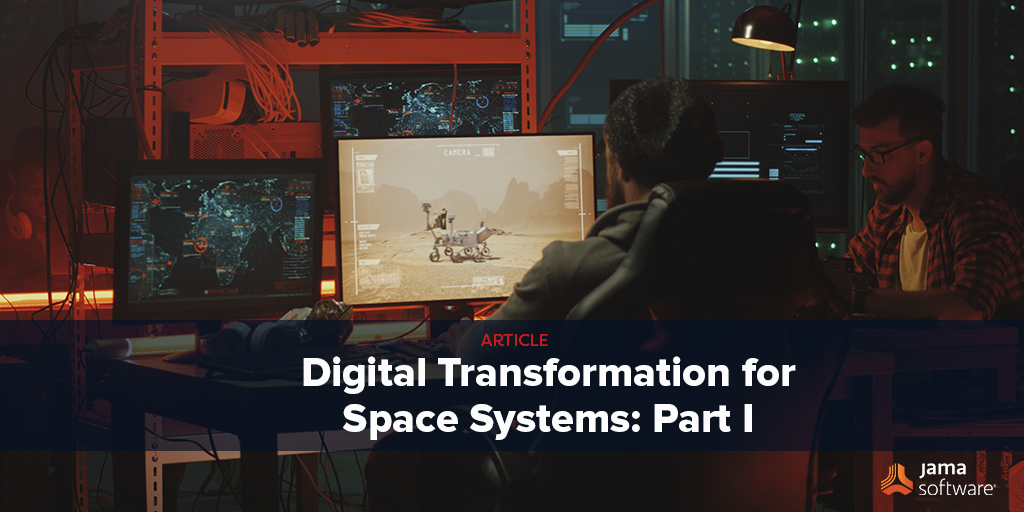
This post is Part I of our two-part series on digital transformation.
The future of Earth might depend on space. Governments from countries around the world and private space companies funded by billionaires are designing new space technologies that push the envelope of technology and complexity. Systems built to operate in the space environment must also be ready for quite a lot of hazards. Here on Earth, we don’t have to worry about operating in a vacuum; getting hit by space debris and micro-sized meteoroids; radiation from the sun and the universe itself; charged particles; or variances in gravity.
Gone are the days where you have a decade or more to design and develop a new system. With changing global economies, dramatically evolving political landscapes, and shrinking pools of money, waste needs to be eliminated from development. Digital engineering strategies are aiming to eliminate wasteful stovepipes in information and communication centered around not just the product development lifecycle but even the acquisition lifecycle. For deployed space systems in many cases, you only get one shot at getting it right.
Digital engineering is an integrated approach that uses authoritative sources of system data and models as a continuum across disciplines to support lifecycle activities from concept through disposal. In the simplest of terms, it is the act of creating, capturing, and integrating data using models and innovative technology in an orchestrated manner in order to unlock greater value and provide positive impacts on cost and schedule. This integrated approach means that the data from the digital models such as CAD models, electrical circuit models, system models, and software models as well as the domain discipline processes are orchestrated tightly. Hardware, systems, and software engineers are now working much more closely to design and develop systems.
At NASA it is believed that “Digital transformation leads to more informed decisions, increased operational efficiency, and streamlined processes.” Digital transformation is not just converting paper records into digital format. It is not about making Word and PDF documents available to more people. Digital transformation is about transforming how you communicate and collaborate with not only your co-workers but also with your customer and suppliers. It is the reinvention of the way processes themselves are performed; it’s not just a change in IT.
New digital engineering tool ecosystems must be flexible and agile enough to be used by broad, cross-functional teams as well as be responsive to technology changes. One key ingredient for digital engineering success is to make use of models. In the systems engineering community MBSE is seen as the state-of-the-art technique. Requirements management however, which is a pillar of systems engineering, extends beyond the systems model. Highly abstract requirements such as stakeholder expectations, mission goals, and concepts of operations as well as design requirements at the element, subsystem, and component level benefit from a model-based approach.
Using Jama Connect for Requirements MBSE
Jama Connect’s unique user interface allows non-technical stakeholders to visualize a model of the system of interest and interact with the requirements in familiar views like documents and spreadsheets. Using Jama Connect in the application of MBSE to create models is supported by a series of pre-defined views and its underlying relationship ontology which enforces the rigor and consistency demanded by the framework. It can also be used in alongside dedicated SysML tools to act as the dedicated requirements system since data organization in Jama Connect is compatible with SysML tools. This makes it attractive to organizations that do not have enough trained staff or licenses to use dedicated SysML graphical modeling tools.
The Human Element of Digital Transformation
Digital transformation is not just about learning to use new tools and incorporation of models but is also about changing to a new company culture and mindset. It becomes necessary for stakeholders and engineers across all disciplines to develop new skills in both systems thinking and real time collaboration. Jama Connect has built-in technology that facilitates better cooperation and communication. It helps eliminate communication silos and becomes a bridge between the requirements data and common communication systems like email. Emails transform to in-app discussions, @mentions, and actions. Requirements reviews in Jama transform into virtual review of data rather than production of documents with iterative reviews of endless redlines. Reviews streamline the feedback sharing process. This reduces the rounds of revision by letting teams give clear feedback on requirements. They don’t need to spend hours figuring out the changes suggested and what needs to be worked upon.
Parting Words
The complexity of space systems and the global race to ensure the future of Earth needs the benefits that transformation to digital engineering brings. Doing this successfully enables you to simplify complex development cycles, bridge collaboration gaps, build quality products, get to space faster, and build safe and successful systems.
To learn more about how Jama Connect for Airborne Systems helps teams to improve their ability to communicate, track, and test requirements for teams in the aerospace industry, download our solution overview.
- The New ARP4754B and Techniques in Jama Connect® for Airborne Systems - February 13, 2025
- [Webinar Recap] The New ARP4754B: Tips for Engineers & Quality Teams - December 30, 2024
- [Webinar Recap] Elevating MBSE with SysML: Jama Connect® and CATIA Magic in Action - September 17, 2024